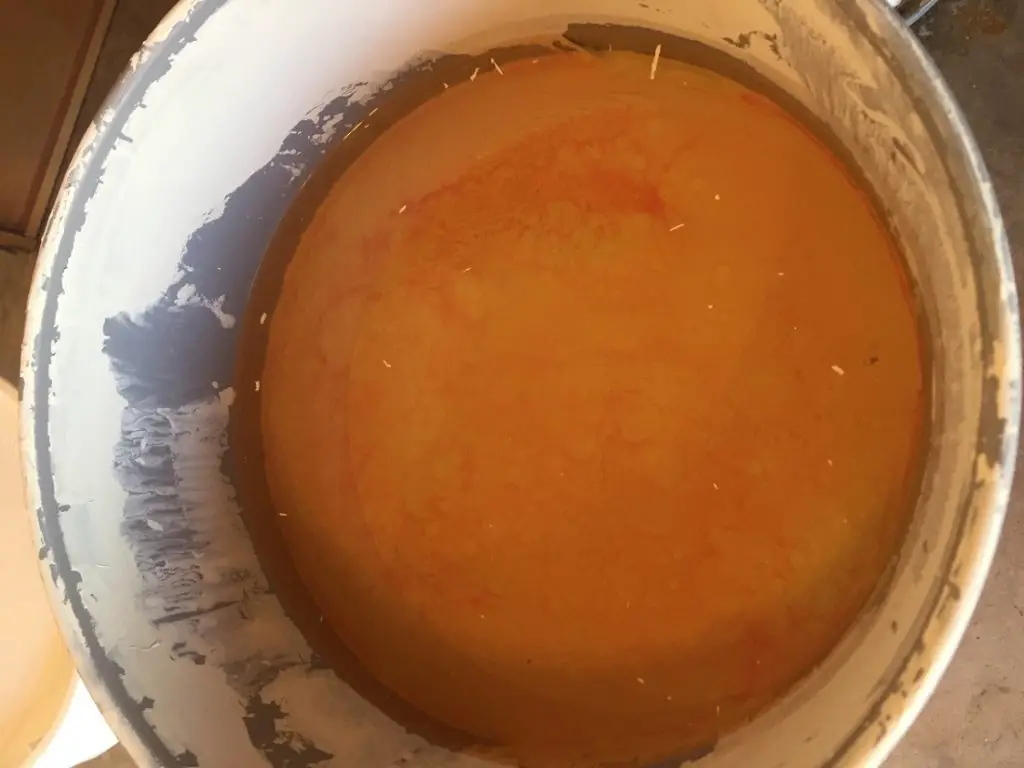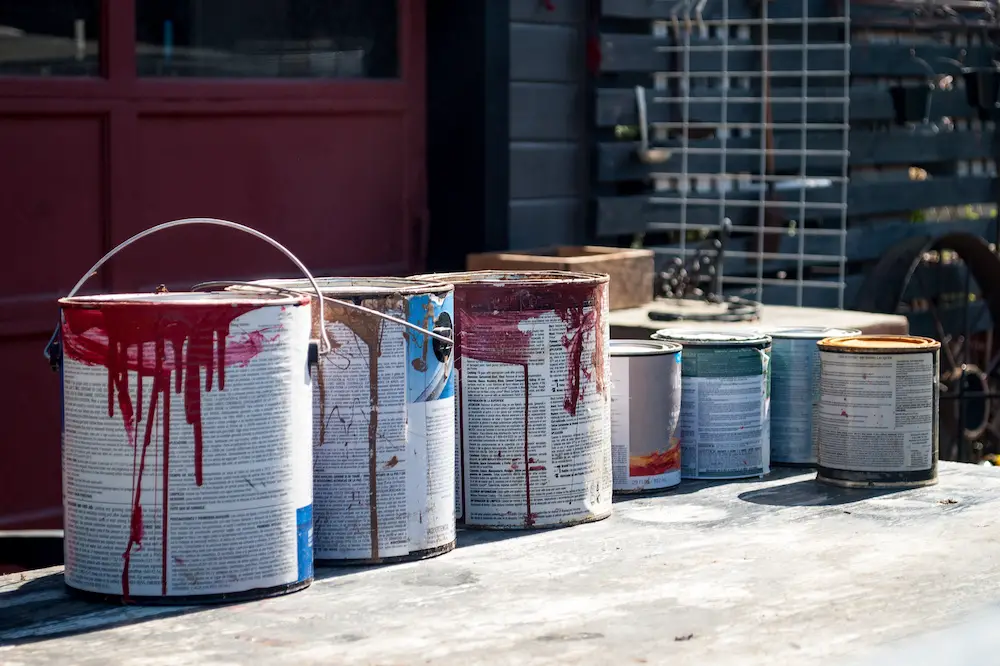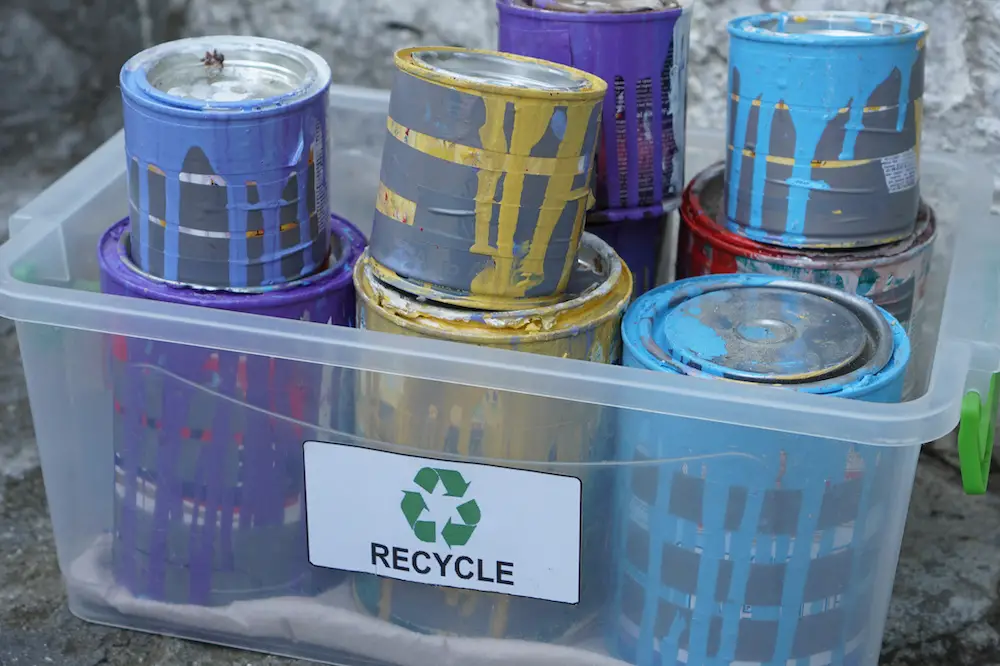Paints contain pigments, binders, solvents, and additives that change consistency if left unused over time.
These ingredients vary according to paint types, which means they have different storage shelf-lives.
If not stored correctly, leftover paint can go rancid, sour-smelling, lumpy, and jelly-like.
When this happens, you will need to learn how to dispose of paint safely and responsibly.
You can store paint and keep it for later use while it lasts, but you will inevitably have to understand how to get rid of old paint.
Got other items to dispose of? We can show you how to dispose of Dry Ice or Bacon Fat, and we even have ways to reuse them!
How Do I Dispose of Unused Paint?
Before disposing of unused paint, it is better to understand the type of paint you have and check whether it has already gone bad.
The shelf-life of paint is highly dependent on the surrounding conditions, which should always be cool and dry.
Additionally, you must completely seal any paint in storage in its container.
Latex paints are water-based paints that can last up to ten years in proper storage.
Oil-based or solvent paints, on the other hand, can last even longer at around 15 years.
Latex paints dry out faster than oil-based paints, and oil-based paints left in open cans may not even harden and dry at all.
To check whether a can of paint has gone bad, consider the following observations.

Smells Different Than It Usually Does
The odor is the key to telling whether water-based paints have lost their value.
Unusable latex paints have a rancid, offensive odor that is more intense than their smell right after first opening the can.
To confirm, get a paint stirrer and mix the contents of the can.
If the paint has hardened at the bottom or on the can interior, it most definitely has gone to waste.
Use a sampling surface and apply the paint with a few strokes if you are quite unsure if it has gone useless or not.
If it results in a flaky surface, it is already useless, and the next step should be proper discarding.
Looks Rubbery
On the other hand, oil-based paints turn to a rubbery consistency as soon as they begin losing quality.
Try applying it on glass and see if the paint is very thick and won’t allow consistent spreading.
No matter how hard you try to mix the contents in a can of oil-based paint, they may not mix up to form the product’s original color.
Sometimes, old oil-based paints appear in different shades on a single stroke of the brush.
You should process rubbery and thick oil-based paints for disposal.
Stone-Hard
This state of water-based paints is a no-brainer. Water-based paints can dry out and become as hard as a stone.
If you come across latex paint that has hardened to a solid unmixable state, then there is nothing left to do but find out how to get rid of it.
Still Usable
Sometimes, after checking all of the unused, leftover paint, you might come across some cans that contain usable paint.
If you have nothing to use it for any time soon, better give it away to be put to good use.
A friend or relative may be doing a DIY project, and they could spend a little less on paints if you donate your usable paint to them.
Who knows, the next time you’ll need some paint, they might return the favor just as quickly.
Alternatively, you can give your leftover paint for use in various public and private institutions.
Churches, non-profit organizations, community service departments, theatrical groups, and youth scout groups may need free second-hand supplies.
Giving them extra needed supplies will help them accomplish more with what they already have, and they can spend their budget on other items for their projects.
Non-profit organizations that may use recycled paint include Habitat for Humanity and Global Paint for Charity.

How to Dispose of Paint Safely and Responsibly
Most paint products contain harsh substances that can pollute the environment and damage our health.
The unlawful disposal of oil-based paints into the environment can contaminate the soil and eventually trickle down to the water table.
The water table is where we get water for our drinking needs and other day-to-day water requirements.
Any spilled paint, especially oil-based ones, can start a chain of events that will eventually lead to the death of land and the poisoning of water.
As global warming and rampant exploitation of natural resources continue to damage the planet, more and more environmental laws come into play.
Sometimes, you might think that disposal and storage regulations make it easier to store than to throw away leftover paint.
So, how do you dispose of paint the right way? Who can help you get rid of it so it doesn’t just waste away in storage?
What should you do to prevent environmental damage from unused paint?
Below are the surefire ways to get rid of old paint without causing harm to the environment and personal health.
Wear Safety Gear Before Handling Paints
Leftover paints may have volatile compounds that fill up the air as soon as the paint cans are opened.
Inhaling these compounds can cause severe health conditions.
When handling leftover paint, wear a respirator mask or at least a face mask that can protect you from breathing in the fumes emitted by these volatile compounds.
You might want to use a fan for ventilation or an air purifier to eliminate the odors while working around paints indoors.
At the slightest chance that inhalation of these chemicals leaves you nauseous or with a bad headache, leave the area and consult with a physician to get some help.
Take Advantage of Recycling Centers
Answering the question, how do you dispose of paint, can be as easy as knowing where to dispose of paint.
When trying to get rid of paint, look for local recycling centers because you’ll never know when you might have one nearby.
Most paint factories have a center for paint recycling. They will know what to do with leftover paints, especially those oil-based types.
Some paint manufacturers make innovations in making new paint products assembled from recycled paint.
General-use recycling centers typically collect leftover paints, and they turn them over to paint-recycling factories.
Inquire at Your Local Waste Management Authority
You may not know about recycling centers near you, and you might not have any idea about local paint disposal regulations.
Call or inquire at your local waste management authority and ask about paint disposal practices available in your area.
If you are trying to dispose of latex paints, this is an excellent time to ask whether dumping dried and completely hardened water-based paints in collection dumpsters is allowed or not.
They most probably will tell you where to dispose of paint near your address.
Leave It Out to Dry Completely
Old, unused oil-based paints still in their opened cans can never dry as fast as latex paints.
As a result, the disposal of oil-based paints requires a little more care than latex paints.
Trying to dry out old, leftover latex paint depends on how much you have.
Half a Gallon or Less
If you have small amounts of latex paints, leave them out in the sun and in their original can to dry.
Stir its contents regularly since stirring speeds up the drying process.
Remember to choose a well-ventilated area that is inaccessible to children and pets.
A Gallon or More
Large amounts of latex paint require more time to dry, but it can be sped up using a few techniques.
You can use a thick cardboard box sitting under the sun.
Pour layers of paint up to one inch thick into each cardboard box, and wait for each layer to harden and dry before adding in the next layer.
Add porous materials into each layer to speed up the drying time even more.
Sawdust and sand are both excellent choices. Alternatively, you can use a brush or paint roller and use up all the paint on newspaper sheets.
Can You Throw Paint In the Bin?
While throwing oil-based paints into trash bins is illegal in most US States, standard waste disposal of latex paints is allowed in some areas.
As long as latex paint has wholly hardened and dried, you can throw it out in trash bins.
Can I Use Kitty Litter to Harden Paint?
If you have several cats at home, cat litter is another excellent material for drying latex paint.
Mix cat litter with every layer of latex paint in the same cardboard box if you do not have sand or sawdust.

Conclusion
Paints have a highly transformative effect on both interior and exterior spaces, and they can change the overall appearance of objects.
However, having too much paint may cause severe problems not only for the environment but also to human health.
With every construction project finished, there’s almost always leftover paint.
Completing any DIY project involves finding out how to dispose of paint that will seem to go to waste if not used in other applications.
Either donate them to family or friends or have them recycled as instructed by your local government.

